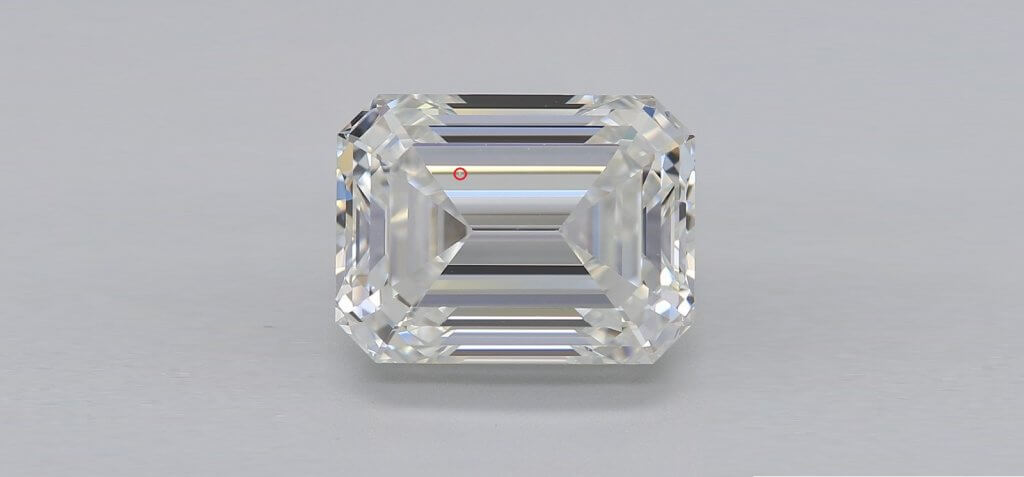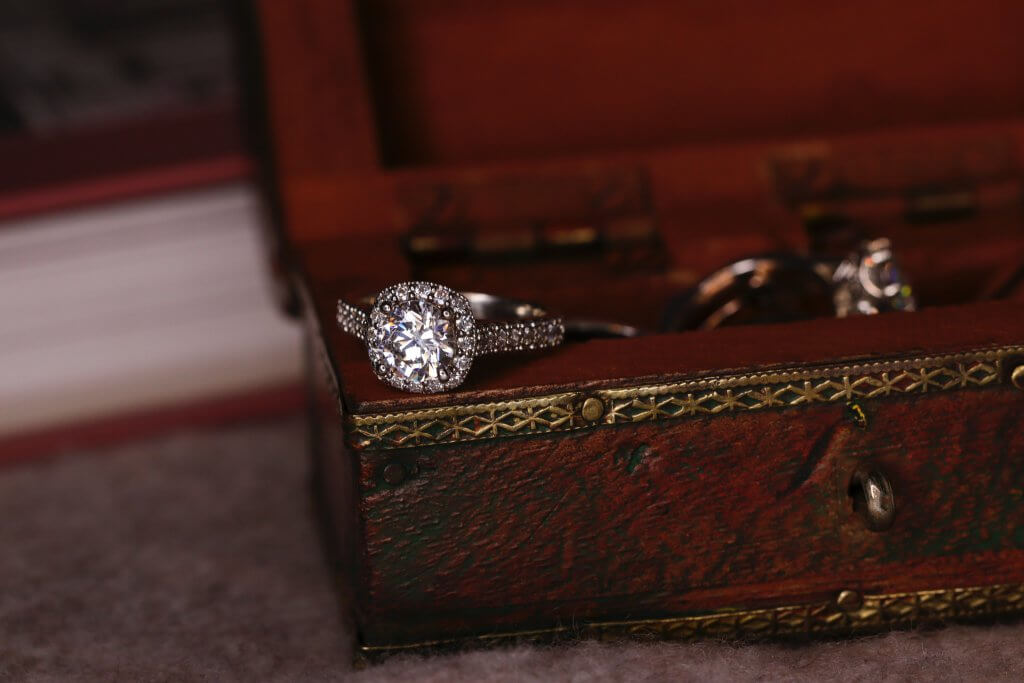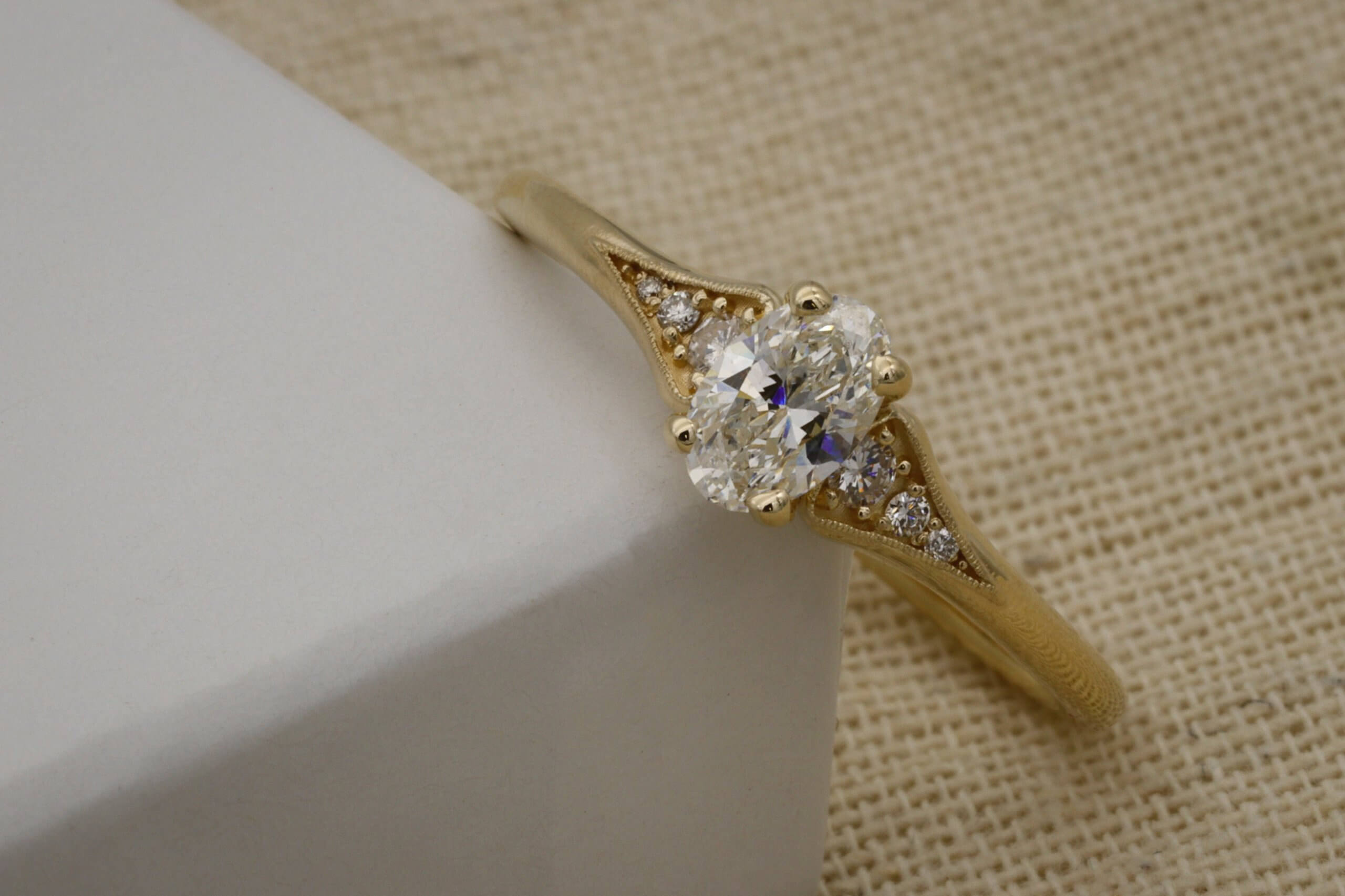The Ultimate Guide To VVS1 Diamonds

On the surface of things, VVS1 diamonds look like the ideal choice for anyone with a healthy budget, and a commitment to tracking down the very best diamond money can buy for their future bride.
And why not? They represent a premium clarity grade, without forcing you to stray unnecessarily into the very expensive waters of FL and IF Diamonds. By now, you probably know full well that, to the naked eye, there is no difference between FL and VVS diamonds, so why not take this route and invest in a high quality VVS diamond?
Then again, it’s just as likely that you’ve landed on this page by chance, and still have no idea what a VVS diamond even is – although, already, you’ve probably gathered that they’re high quality…
What Does VVS1 Mean in Diamonds?
VVS1 is a clarity grade, meaning ‘Very Very Slight Inclusions 1’. It is the first grade to follow from Internally Flawless, meaning that it is the third highest grade on the entire GIA Clarity Scale.
More technically, a grade of VVS means that any inclusions are visible only under 10x magnification, and that even a skilled diamond grader will struggle to see them.
In other words, the diamond’s flaws are so minor that they barely impact its appearance under magnification – and, as a result, have no impact on the appearance of the diamond outside of the grader’s lab.
Are VVS Diamonds High Quality?
Yes, VVS1 diamonds represent an exceptionally high quality.
What’s more, given the rarity (and steep price) of FL and IF diamonds, VVS1 diamonds represent the very pinnacle of what most buyers could feasibly attain – although, of course, they really don’t need to go that far.
How Rare is a VVS1 Diamond?
Less than 10% of all diamonds mined are found to be VVS1 or VVS2 quality.
This may sound like a very small fraction of diamonds but, considering the fact that FL diamonds account for less than half a percentage of all diamonds mined, VVS diamonds are considerably more common. However, their proximity to the flawless grades means that they still have a premium cost attached to them.
As a result, it’s nowhere near as unusual for VVS diamonds to appear on the market as it is for Internally Flawless diamonds to appear. That said, the overwhelming majority of reputable jewelers will likely steer their clients away from this grade, and toward some of the more affordable eye clean grades, in order to ensure they’re not investing too much into one of the four Cs, and not enough into another.
Which is Better VVS1 or VVS2?
VVS1 is a higher grade for clarity than VVS2. In the case of a VVS2 diamond, the inclusions are a little easier to detect than they are for VVS1 diamond, although they certainly still require 10x magnification, and will still be trickier to find than a diamond with a slightly lower clarity.
There is, however, so little difference between the two grades that anyone shopping for a diamond of this quality doesn’t need to give too much consideration to the question of VVS1 vs VVS2.
VVS1 diamonds will cost more than comparable diamonds graded at VVS2, although, without a magnifying glass, neither one will appear noticeably higher in quality than the other.
Is VS1 or VVS1 Better?
VVS1 is two grades higher than VS1 on the GIA Clarity Scale, and indicates that a diamond features fewer noticeable inclusions under 10x magnification than VS1.
It’s easy enough to get tripped up by these similar abbreviations in the beginning, but it is useful for you to get your head around the differences between a VVS diamond and a VS diamond.
The most significant difference between these two grades is cost. A one carat VVS1 diamond could cost $1,000+ more than a one carat VS1 diamond with a comparable cut and color, and the difference could grow more significant with the sizes of the diamonds in question.
Under the microscope, the difference remains pretty marginal. VS1 diamonds are still eye clean, and can still be a little tricky for graders to spot. As a result, the naked eye can detect no difference between these two grades.

Do VVS Diamonds Sparkle More?
No, and this is an unfortunate (and pretty common) misconception among shoppers – one that leads some to spend more than they need to on clarity.
If you got together a handful of guys currently shopping for their engagement ring and asked what their priorities were, then sparkle would no doubt sit pretty high on that list – if not at the very top. After all, before her eyes are able to take-in the all-round beauty of your chosen ring, they’re going to be dazzled by an explosion of brilliance and fire – or so you’re hoping.
Let’s get one thing straight. Cut determines sparkle more than any other factor. Light needs to rebound throughout the diamond and across its many facets in order to generate that coveted sparkle we all want to find.
This is why round cut diamonds sparkle differently to emerald cut diamonds, for instance: the designs of their facets are basically polar opposites to one another.
Clarity, on the other hand, matters very little – and not until you get so far down the scale that you’re looking at a diamond with obvious inclusions large enough to be seen clearly without any magnification equipment or specialist knowledge. In diamonds of this quality, inclusions can prevent light from travelling through the diamond as it needs to in order to generate the best sparkle, but you run no risk of that if you stick to the eye clean grades.
Is VVS1 Clearer?
No – the diamond’s color grade determines how clear it is.
Clear diamonds can take on a yellow-hue during their development deep underground – something that is, for obvious reasons, considered a definite dealbreaker for the majority of people purchasing diamonds for jewelry.
And, while discoloration is considered a flaw in clear diamonds, it is not accounted for by the clarity grade, which refers only to inclusions.
You can still find VVS1 diamonds with very poor color grades, just as you can find D or E color diamonds with pretty obvious inclusions. In other words, a clarity grade of VVS1 does not mean that the diamond will be of a high enough quality to be used in fine jewelry, so don’t ‘put all your eggs in one basket’ by focusing on clarity alone.
There’s a little more to consider when it comes to color vs clarity but, for now, suffice to say that you need to consider both of these categories as entirely separate concerns during your search for the perfect diamond.
How Much is a 1 Carat VVS1 Diamond?
Provided the diamond also has a good color grade and cut, prices should be expected to start at around $5,000+.
As always, however, the price is apt to increase exponentially. A 2 carat VVS1 diamond with good cut and color grades will likely cost three to four times the price of its 1 carat counterpart.
This high cost is largely derived from quite how close to perfect the VVS1 clarity grade really is. While not quite as coveted as the IF diamond, the VVS1 diamond will still prick the ears of avid collectors – and, of course, those shopping for the best diamonds to set in an engagement ring.
Even so, we’re not huge proponents of the VVS1 clarity grade for any bride-to-be.
What is D VVS1?
A D-VVS1 diamond is one that has been given a color rating of D (the highest color grade), and, of course, a clarity grade of VVS1.
This would be a very high quality diamond, with no discernible color and no inclusions visible to the naked eye. It would, of course, demand an incredibly high price on the market (provided it featured a strong grade for cut), and one that the average shopper really doesn’t need to consider paying.
Just like the VVS clarity grade, D Color Diamonds are considered to be highly valuable due to their rarity and quality. However, their appearance outside of the lab (away from ideal lighting conditions and strong magnification) is not distinguishable from other diamonds of lower grades so, again, you can aim a little lower and afford a larger diamond for the same beautiful appearance.
Is a VVS1 Round Diamond Good?
If the cut is graded at Excellent or Very good, a Round VVS1 diamond will look beautiful – but so will any eye clean diamond, however low its clarity grade is.
Round diamonds remain the most popular shape for a very good reason: no other shape ever created is capable of rivalling its incredible sparkle.
To maximize that sparkle, you’ll want to find a diamond with great proportions, symmetry and polish – and, in all likelihood, you’ll want to find the biggest one that money can afford. If you opt for a VVS1 or VVS2 diamond, you might find yourself pretty limited in terms of carat weight – and, if so, needlessly disappointed.
So, Should You Buy a VVS1 Diamond?
No, we’re gonna have to give this one a hard pass. When it’s possible to buy a diamond that looks just as perfect as a VVS1, but for a fraction of the price, then it’s clear where your allegiances should lie.
We’re willing to admit there’s a certain number of bragging rights for anyone whose diamond is so close to perfection. Since FL and IF are unfeasible choices for the majority of buyers, VVS1 diamonds may as well represent the very best money can buy – and we definitely can’t argue with the allure of that.
Still, once the novelty of what’s written within your diamonds GIA Report wears off, you’ll have to face up to the fact that you paid thousands of dollars for a difference that goes unseen by the naked eye.
Let’s put it another way. If you’re working with a $10,000 budget, then you could easily spend pretty much all of it on a VVS1 diamond sitting around the 1 carat mark – and, as a result, have only a small amount left for the ring setting itself.
If you opt for an eye clean diamond graded at VS1 or VS2, you’re opening up your budget to invest more into cut, color, and carat weight – and, again, the ring setting – without missing out on the visual impact of the VVS diamond.
It’s your call to make but, whatever your budget, maximizing all aspects of the diamond rather than just one (in this case, clarity) represents a much wiser decision, and one that will get you a better ring in the end.
5 Key Takeaways
- VVS1 diamonds are a clarity grade which literally means ‘very very small inclusions’.
- They are more common than FL diamonds, but most buyers will not have to go that far in their search for the perfect engagement ring.
- There is a misconception amongst buyers that a VVS1 diamond will sparkle more than a lower grade one, but this is untrue.
- The cut of a diamond will more likely determine its sparkle, and the diamonds cool grade will better determine its clearness.
- Instead of going for a VVS1 diamond, it will be better to maximize the importance of all aspects a diamond. This will be better for your budget and the beauty of the engagement ring you end up with.

Jul 18, 2022 By Willyou.net
The Unexpected Side Of VVS Diamond Clarity Grade

Sep 9, 2021 By Willyou.net
Why Flawless Diamonds May Not Be Worth The Investment








